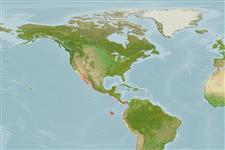>
Gobiiformes (Gobies) >
Gobiidae (Gobies) > Gobionellinae
Etymology: Ctenogobius: Greek, kteis, ktenos = comb + Latin, gobius = gudgeon (Ref. 45335).
More on author: Günther.
Environment: milieu / climate zone / rango de profundidad / distribution range
Ecología
marino; salobre demersal. Subtropical; 35°N - 19°S, 121°W - 70°E
Eastern Pacific: San Diego Bay, California, USA (Ref. 2850) to Peru.
Tamaño / Peso / Age
Madurez: Lm ? range ? - ? cm
Max length : 20.0 cm TL macho / no sexado; (Ref. 2850)
Short description
Claves de identificación | Morfología | Morfometría
Facultative air-breathing (Ref. 126274); Inhabits shallow sand or mud bottoms of bays and estuaries. An intertidal species that actively shuttles back and forth between rock pools and air (Ref. 31184). For food ingestion it leaves the home pool during low tides, takes a mouth full of mud and returns to its pool where it washes out the mud through its gill membrane and swallows particles which are sieved by the gill rakers (Ref. 92840). Breathes air when out of water (Ref. 31184).
Life cycle and mating behavior
Madurez | Reproducción | Puesta | Huevos | Fecundidad | Larva
Allen, G.R. and D.R. Robertson, 1994. Fishes of the tropical eastern Pacific. University of Hawaii Press, Honolulu. 332 p. (Ref. 11482)
IUCN Red List Status (Ref. 130435: Version 2024-2)
Threat to humans
Harmless
Human uses
Herramientas
Special reports
Download XML
Fuentes de Internet
Estimates based on models
Preferred temperature (Referencia
123201): 19.5 - 28.9, mean 24.5 °C (based on 268 cells).
Phylogenetic diversity index (Referencia
82804): PD
50 = 0.5000 [Uniqueness, from 0.5 = low to 2.0 = high].
Bayesian length-weight: a=0.00708 (0.00449 - 0.01117), b=2.85 (2.72 - 2.98), in cm total length, based on LWR estimates for this species & (Sub)family-body (Ref.
93245).
Nivel trófico (Referencia
69278): 3.7 ±0.5 se; based on size and trophs of closest relatives
Resiliencia (Referencia
120179): Medio, población duplicada en un tiempo mínimo de 1.4-4.4 años (Preliminary K or Fecundity.).
Fishing Vulnerability (Ref.
59153): Low vulnerability (10 of 100).
🛈
